Energy Efficient Design of Massive MIMO by Considering the Effects of Nonlinear Amplifiers
Abstract
:1. Introduction
- (1)
- The energy efficient design of Massive MIMO along with the effects of nonlinear amplifiers under the perfect and imperfect channel conditions, and by using the realistic power consumption model, is first proposed and formulated.
- (2)
- Mathematical expressions of the spectral efficiency and energy efficiency are derived by considering the effects of nonlinear amplifiers in each transmitter branch under the perfect and imperfect channel conditions.
- (3)
- A numerical approach is proposed to optimize the energy efficiency and calculation of optimal parameters. Simulation results are provided to support the mathematical modelling and investigate the relevant trend.
2. Frame Structure and Achievable Rates of Massive MIMO
2.1. Achievable Rates of Massive MIMO under Perfect CSI
2.2. Achievable Rates of Massive MIMO under Imperfect CSI
3. Modeling of Power Consumptions
4. Energy Efficiency and Problem Formation
4.1. Energy Efficiency under Perfect CSI
4.2. Energy Efficiency under Imperfect CSI
5. Modeling of Nonlinear Amplifiers
6. Problem Solution and Numerical Algorithm
7. Simulations and Numerical Results
8. Conclusions
Author Contributions
Acknowledgments
Conflicts of Interest
Abbreviations
Appendix A
- Check of quasi-concavity for when the other parameters are fixed in the interval .
- Check of quasi-concavity for when the other parameters are fixed in the interval .
- Check of quasi-concavity for when the other parameters are fixed in the interval .
Appendix B
- Under imperfect channel conditions in the case of , it comes out to be the same as Equation (33) when the other dimensions are fixed in the interval . Similarly, for it comes out to be the same as Equation (35) when the other dimensions are fixed in the interval but substitute in Equations (34) and (35).
- Check of quasi concavity for when the other parameters are fixed in the intervalAs we know that the energy efficiency under the imperfect channel conditions can be written as:thus, (37) can be written as:
References
- Thomas, M.; Larsson, E.G.; Yang, H. Hien Quoc Ngoet, 1st ed.; Fundamentals of Massive MIMO, Cambridge University Press: Cambridge, MA, USA, 2016. [Google Scholar]
- Ramezani, P.; Jamalipour, A. Toward the evolution of wireless powered communication networks for the future Internet of Things. IEEE Netw. 2018, 6, 62–69. [Google Scholar] [CrossRef]
- Caire, G.; Jindal, N.; Kobayashi, M.; Ravindran, N. Multiuser MIMO achievable rates with downlink training and channel state feedback. IEEE Trans. Inf. Theory 2010, 56, 2845–2866. [Google Scholar] [CrossRef]
- Jose, J.; Ashikhmin, A.; Marzetta, T.L.; Vishwanath, S. Pilot contamination and precoding in multi-cell TDD systems. IEEE Trans. Wirel. Commun. 2011, 10, 2640–2651. [Google Scholar] [CrossRef]
- Verdú, S. Multiuser Detection; Cambridge University Press: Cambridge, MA, USA, 1998. [Google Scholar]
- Viswanath, P.; Tse, D.N.C. Sum capacity of the vector Gaussian broadcast channel and uplink-downlink duality. IEEE Trans. Inf. Theory 2003, 49, 1912–1921. [Google Scholar] [CrossRef]
- Weingarten, H.; Steinberg, Y.; Shamai, S. The capacity region of the Gaussian multiple-input multiple-output broadcast channel. IEEE Trans. Inf. Theory 2006, 52, 3936–3964. [Google Scholar] [CrossRef]
- Li, Q.; Li, G.; Lee, W.; Lee, M.I.; Mazzarese, D.; Clerckx, B.; Li, Z. Mimo techniques in wimax and lte: A feature overview. IEEE Commun. Mag. 2010, 48, 86–92. [Google Scholar] [CrossRef]
- Hanzo, L.; Akhtman, Y.; Wang, L.; Jiang, M. MIMO-OFDM for LTE, WiFi and WiMAX: Coherent versus Non-coherent and Cooperative Turbo Transceivers; IEEE Press and John Wiley & Sons: New York, NY, USA, 2010. [Google Scholar]
- Marzetta, T.L. Noncooperative cellular wireless with unlimited numbers of BS antennas. IEEE Trans. Wirel. Commun. 2010, 9, 3590–3600. [Google Scholar] [CrossRef]
- Björnson, E.; Larsson, E.G.; Marzetta, T.L. Massive MIMO: Ten myths and one critical question. IEEE Commun. Mag. 2016, 54, 114–123. [Google Scholar] [CrossRef]
- Kamga, G.N.; Xia, M.; Assa, S. Spectral-Efficiency Analysis of Regular- and Large-Scale (Massive) MIMO with a Comprehensive Channel Model. IEEE Trans. Veh. Technol. 2017, 66, 4984–4996. [Google Scholar] [CrossRef]
- Xu, J.; Li, S.; Qiu, L.; Slimane, B.S.; Yu, C. Energy efficient downlink MIMO transmission with linear precoding. Sci. Chin. Inf. Sci. 2013, 56, 1–12. [Google Scholar] [CrossRef]
- Larsson, E.G.; Richter, F.; Fehske, A.J.; Fettweis, G.P. Energy efficiency aspects of base station deployment strategies for cellular networks. In Proceedings of the 2009 IEEE 70th Vehicular Technology Conference Fall (VTC 2009-Fall), Anchorage, AK, USA, 20–23 September 2009. [Google Scholar]
- Yang, Y.; You, X.; Juntti, M.; Wang, C.; Leib, H.; Ding, Z. Guest editorial spectrum and energy efficient design of wireless communication networks: Part, I. IEEE J. Sel. Areas Commun. 2013, 31, 825–828. [Google Scholar] [CrossRef]
- Min, R.; Chandrakasan, A. A Framework for Energy-Scalable Communication in High-Density Wireless Networks. In Proceedings of the 2002 international symposium on Low power electronics and design (ISLPED ‘02), Monterey, CA, USA, 12–14 August 2002; pp. 36–41. [Google Scholar]
- Cui, S.; Goldsmith, A.J.; Bahai, A. Energy-efficiency of MIMO and cooperative MIMO techniques in sensor networks. IEEE J. Sel. Areas Commun. 2004, 22, 1089–1098. [Google Scholar] [CrossRef]
- He, A.; Srikanteswara, S.; Reed, J.H.; Chen, X.; Tranter, W.H.; Bae, K.K.; Sajadieh, M. Minimizing energy consumption using cognitive radio. In Proceedings of the IEEE International Performance, Computing and Communications Conference, Austin, TX, USA, 7–9 December 2008. [Google Scholar]
- He, A.; Srikanteswara, S.; Bae, K.K.; Newman, T.R.; Reed, J.H.; Tranter, W.H.; Sajadieh, M.; Verhelst, M. System power consumption minimization for multichannel communications using cognitive radio. In Proceedings of the IEEE International Conference on Microwaves, Communications, Antennas and Electronics Systems, Tel Aviv, Isreal, 9–11 November 2009. [Google Scholar]
- Cui, S.; Goldsmith, A.J.; Bahai, A. Energy constrained modulation optimization. IEEE Trans. Wirel. Commun. 2005, 4, 2349–2360. [Google Scholar]
- Gao, S.; Qian, L.; Vaman, D.R.; Qu, Q. Energy efficient adaptive modulation in wireless cognitive radio sensor networks. In Proceedings of the IEEE International Conference on Communications, Glasgow, Scotland, 24–28 June 2007. [Google Scholar]
- Kim, H.S.; Daneshrad, B. Energy-aware link adaptation for MIMO OFDM based wireless communication. In Proceedings of the IEEE Military Communications Conference (MILCOM 2008), San Diego, CA, USA, 16–19 November 2008. [Google Scholar]
- Mohammed, E.S. Impact of transceiver power consumption on the energy efficiency spectral efficiency tradeoff of zero-forcing detector in massive MIMO systems. IEEE Trans. Commun. 2014, 62. [Google Scholar] [CrossRef]
- Björnson, E.; Sanguinetti, L.; Hoydis, J.; Debbah, M. Optimal Design of Energy-Efficient Multi-User MIMO Systems: Is Massive MIMO the Answer? IEEE Trans. Wirel. Commun. 2015, 14, 3059–3075. [Google Scholar] [CrossRef]
- Xu, W.; Li, S.; Feng, Z.; Vasilakos, A.V. Joint Parameter Selection for Massive MIMO: An Energy-Efficienct Perspective. IEEE Access 2016, 4, 3719–3731. [Google Scholar] [CrossRef]
- Guerreiro, J.; Dinis, R.; Montezuma, P. Massive MIMO with Nonlinear Amplification: Signal Characterization and Performance Evaluation. In Proceedings of the 2016 IEEE Global Communications Conference, San Diego, CA, USA, 4–8 December 2016. [Google Scholar] [CrossRef]
- Studer, C.; Larsson, E. PAR-aware large-scale multi-user MIMOOFDM downlink. IEEE J. Sel. Areas Commun. 2013, 31, 303–313. [Google Scholar] [CrossRef]
- Mohammed, S.; Larsson, E. Per-antenna constant envelope precoding for large multi-user MIMO systems. IEEE Trans. Commun. 2013, 61, 1059–1071. [Google Scholar] [CrossRef]
- Emil, B. Massive MIMO systems with non-ideal hardware: Energy efficiency, estimation, and capacity limits. IEEE Trans. Inf. Theory 2014, 60, 7112–7139. [Google Scholar]
- Hien Quoc, N.; Larsson, E.G.; Marzetta, T.L. Energy and spectral efficiency of very large multiuser MIMO systems. IEEE Trans. Commun. 2013, 61, 1436–1449. [Google Scholar] [CrossRef]
- Jiang, F.; Chen, J.; Swindlehurst, A.L.; López-Salcedo, J.A. Massive MIMO for Wireless Sensing with a Coherent Multiple Access Channel. IEEE Trans. Signal Process. 2015, 63, 3005–3017. [Google Scholar] [CrossRef]
- Rao, X.; Lau, V.K. Distributed compressive CSIT estimation and feedback for FDD multi-user massive MIMO systems. IEEE Trans. Signal Process. 2014, 62, 3261–3271. [Google Scholar]
- Choi, J.; Love, D.; Bidigare, P. Downlink training techniques for FDD massive MIMO systems: Open-loop and closed-loop training with memory. IEEE J. Sel. Top. Signal Process. 2014, 8, 802–814. [Google Scholar] [CrossRef]
- Jiang, Z.; Molisch, A.; Caire, G.; Niu, Z. Achievable rates of FDD massive MIMO systems with spatial channel correlation. IEEE Trans. Wirel. Commun. 2015, 14, 2868–2882. [Google Scholar] [CrossRef]
- Choi, J.; Chance, Z.; Love, D.; Madhow, U. Noncoherent trelliscoded quantization: A practical limited feedback technique for massive MIMO systems. IEEE Trans. Commun. 2013, 61, 5016–5029. [Google Scholar] [CrossRef]
- Rowe, H. Memoryless nonlinearities with Gaussian input: Elementary results. Bell Syst. Tech. J. 1982, 61, 1519–1526. [Google Scholar] [CrossRef]
- Bj¨ornson, E.; Ottersten, B. A framework for training-based estimation in arbitrarily correlated Rician MIMO channels with Rician disturbance. IEEE Trans. Signal Process. 2010, 58, 1807–1820. [Google Scholar] [CrossRef]
- Ciuonzo, D.; Rossi, P.S.; Dey, S. Massive MIMO channel-aware decision fusion. IEEE Trans. Signal Process. 2015, 63, 604–619. [Google Scholar] [CrossRef]
- Amirpasha, S.; Dey, S.; Ciuonzo, D.; Rossi, P.S. Massive MIMO for Decentralized Estimation of a Correlated Source. IEEE Trans. Signal Process. 2016, 64, 2499–2512. [Google Scholar]
- Khan, A.A.; Uthansakul, P.; Uthansakul, M. Energy Efficiency Design of Massive MIMO by incorporating with Mutual Coupling. Int. J. Commun. Antenna Propag. 2017, 7. [Google Scholar] [CrossRef]
- Ochiai, H. An analysis of band-limited communication systems from amplifier efficiency and distortion prospective. IEEE Trans. Commun. 2013, 61, 1460–1472. [Google Scholar] [CrossRef]
- Mollen, C.E.; Larsson, G.; Erikson, T. On the impact of PA-Induced In-Band Distortion in Massive MIMO. In Proceedings of the 20th European Wireless Conference, Spain, 14–16 May 2014. [Google Scholar]

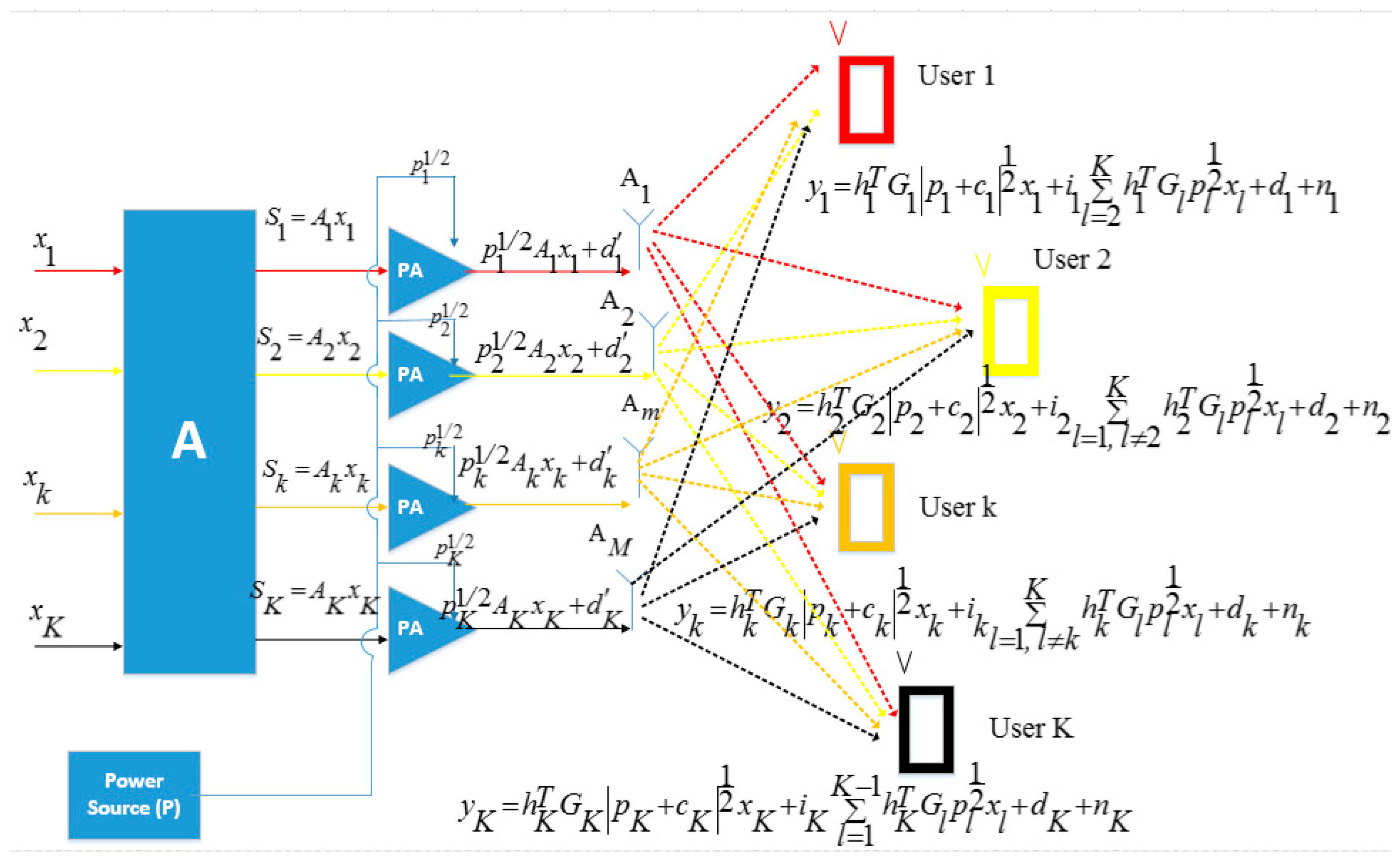
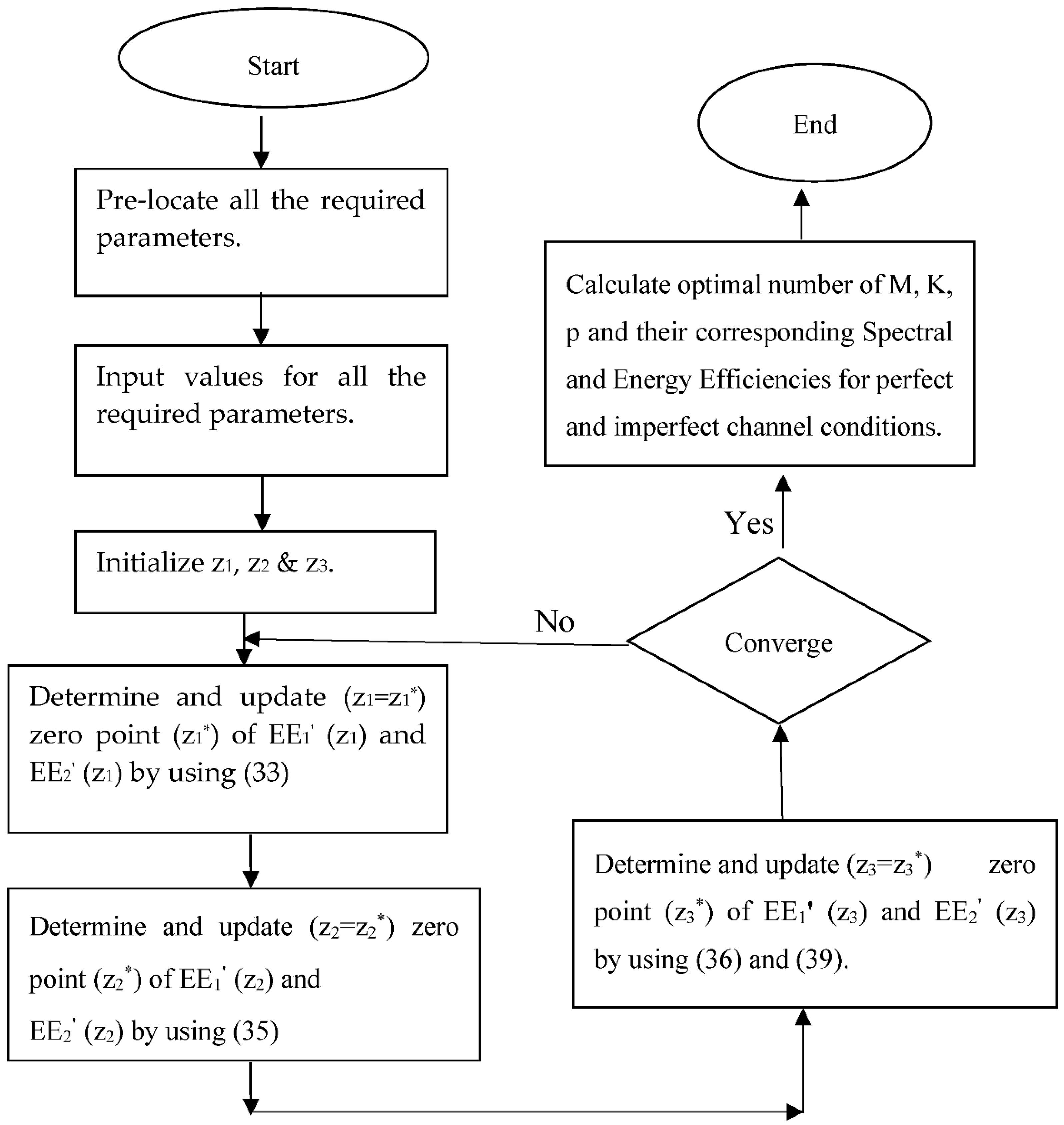
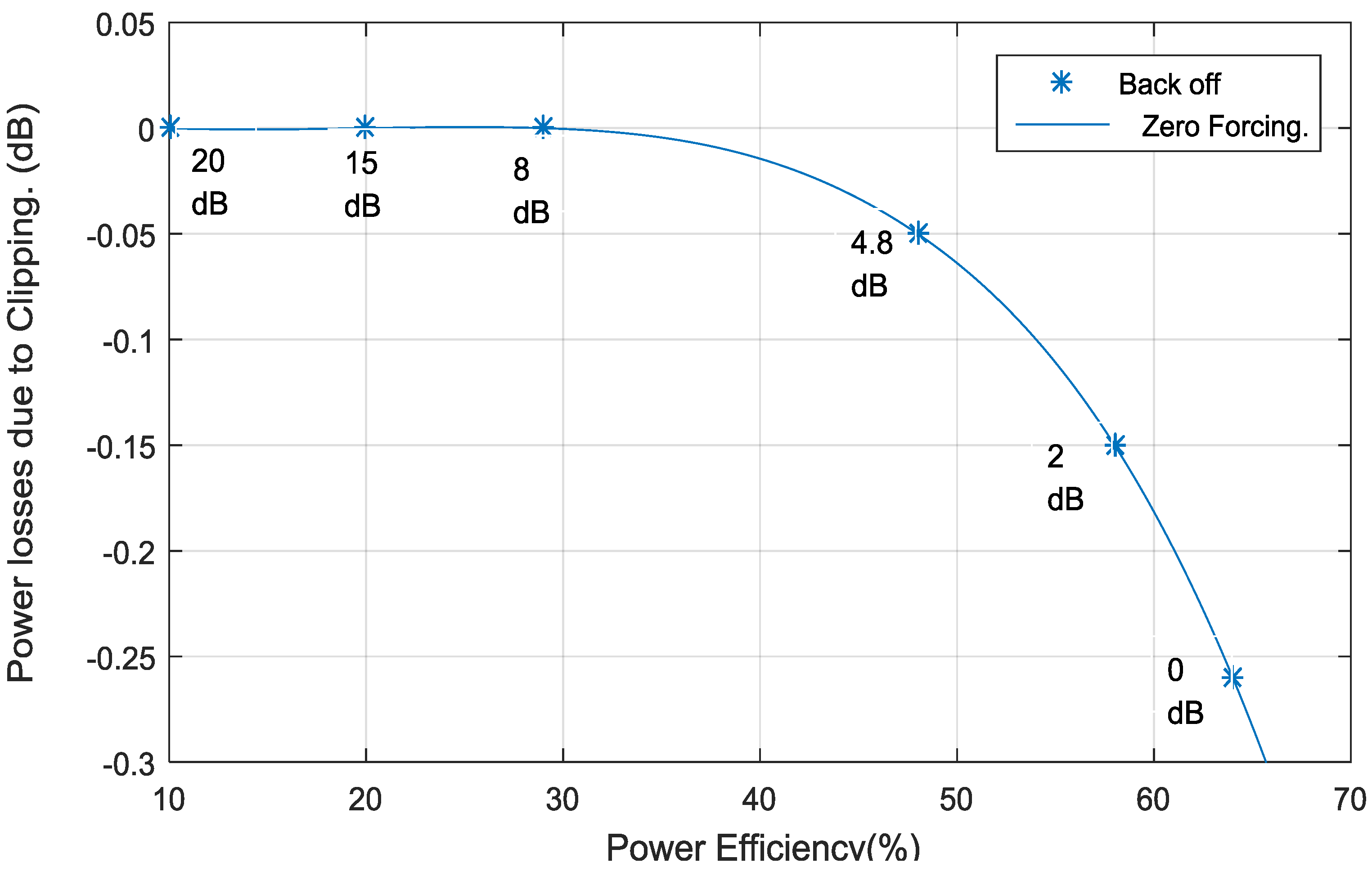

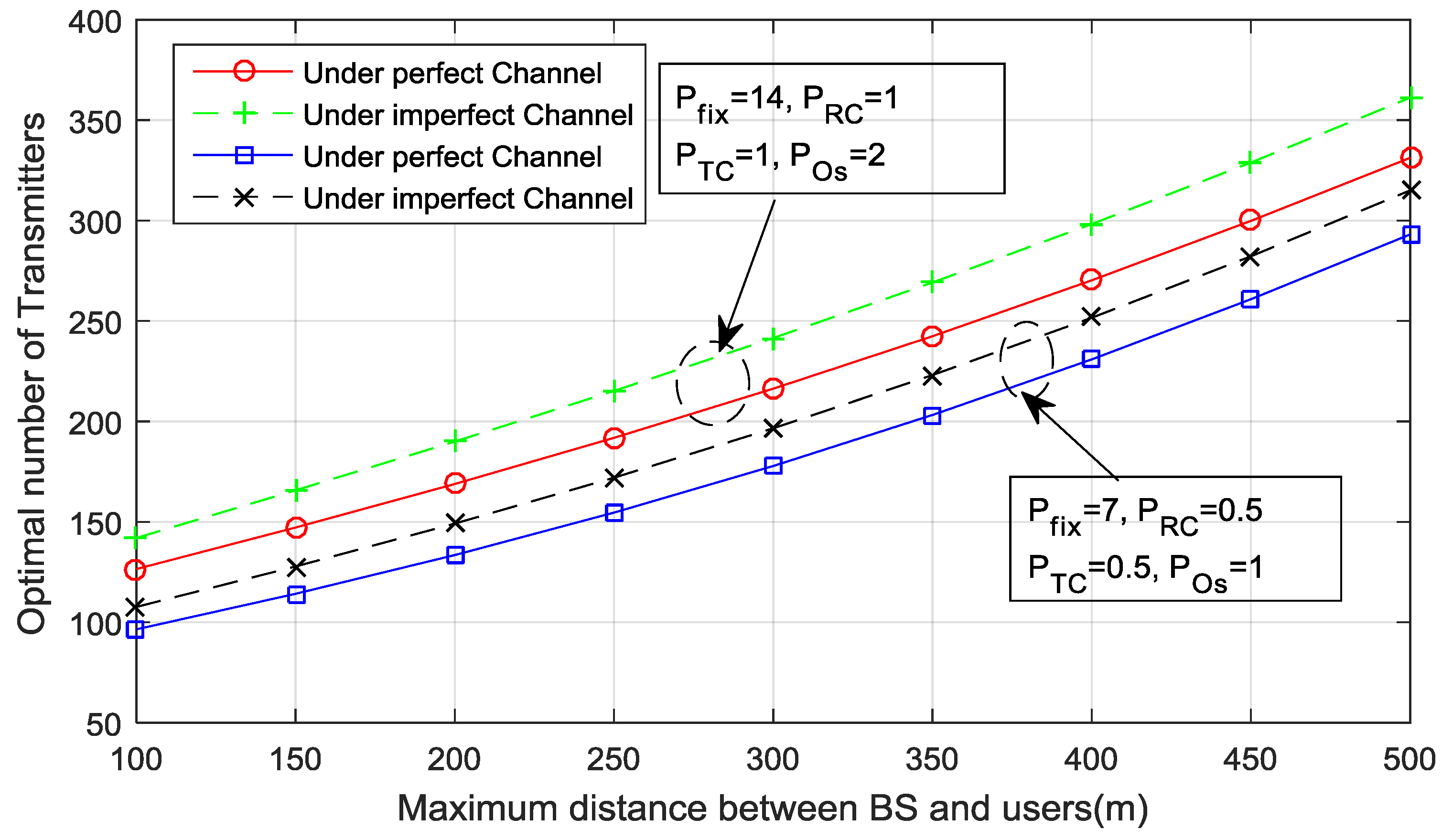



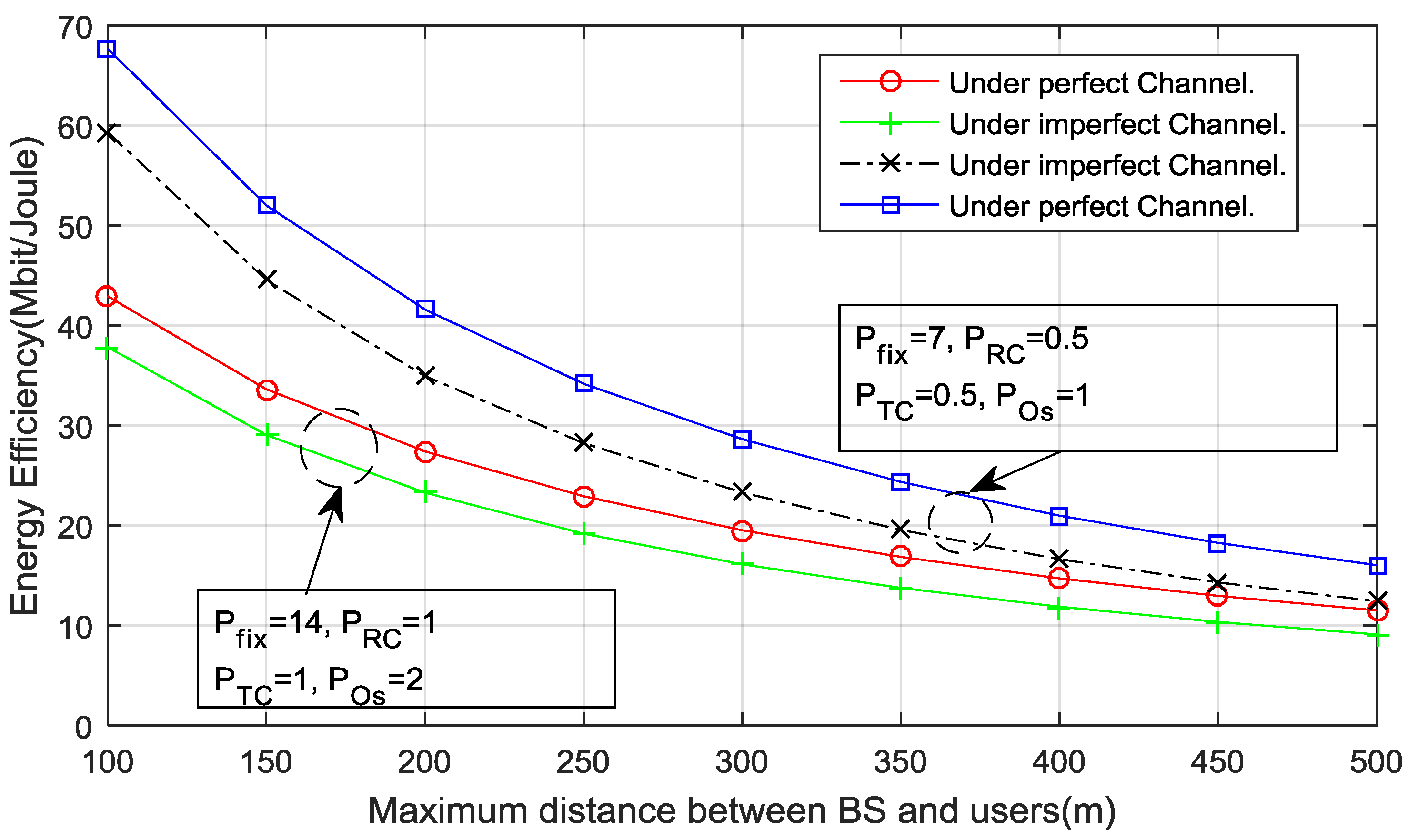
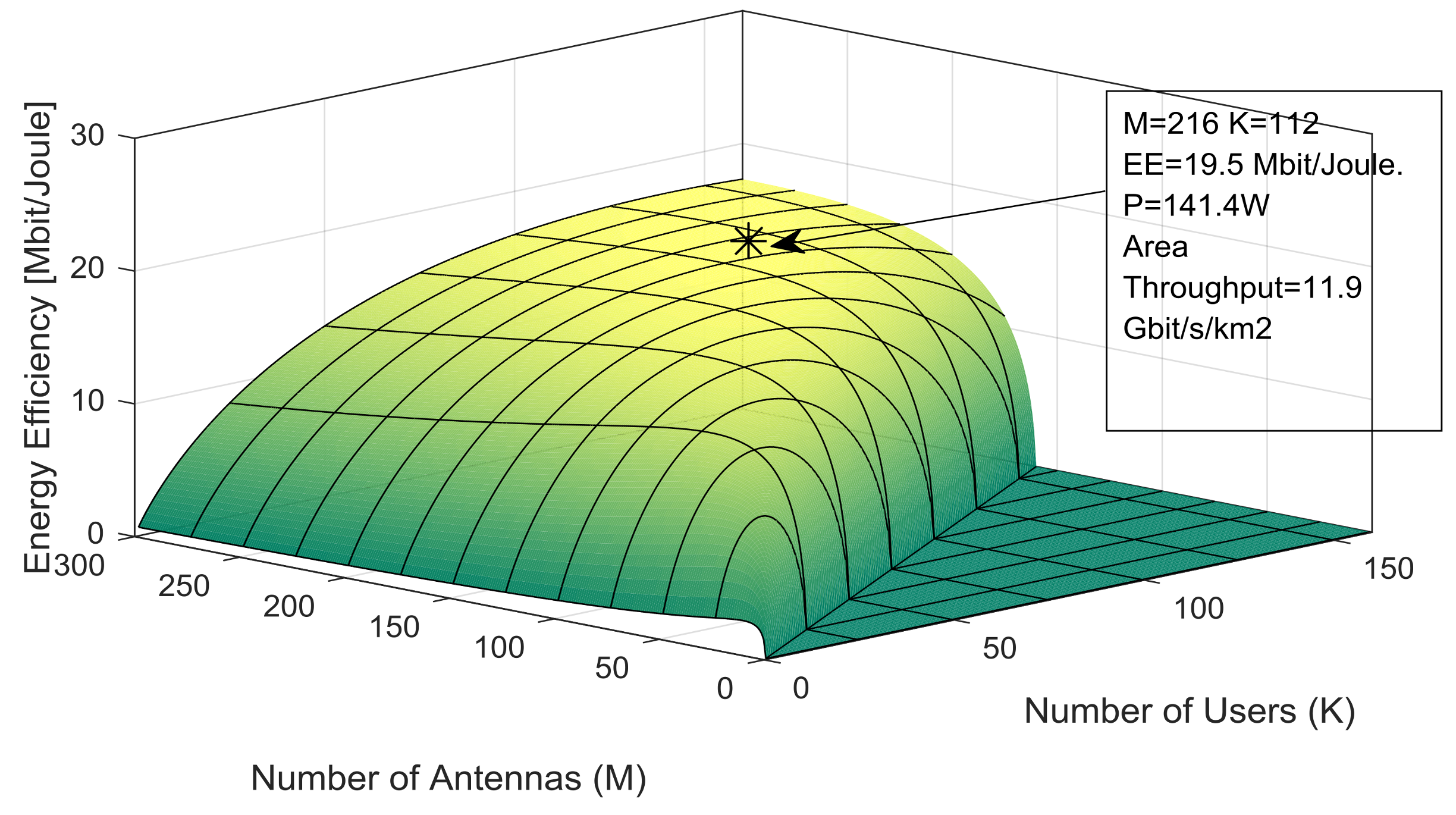
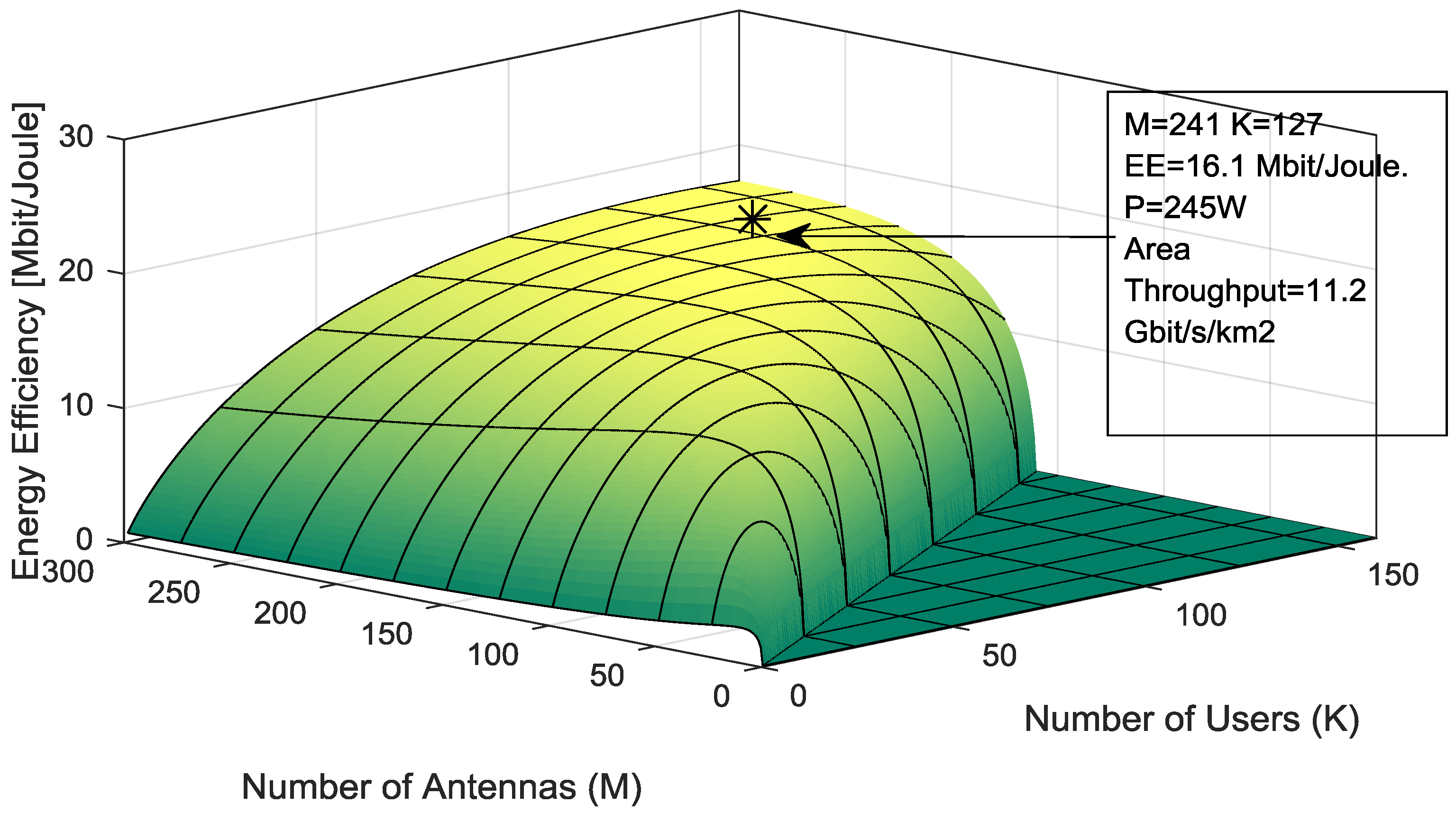
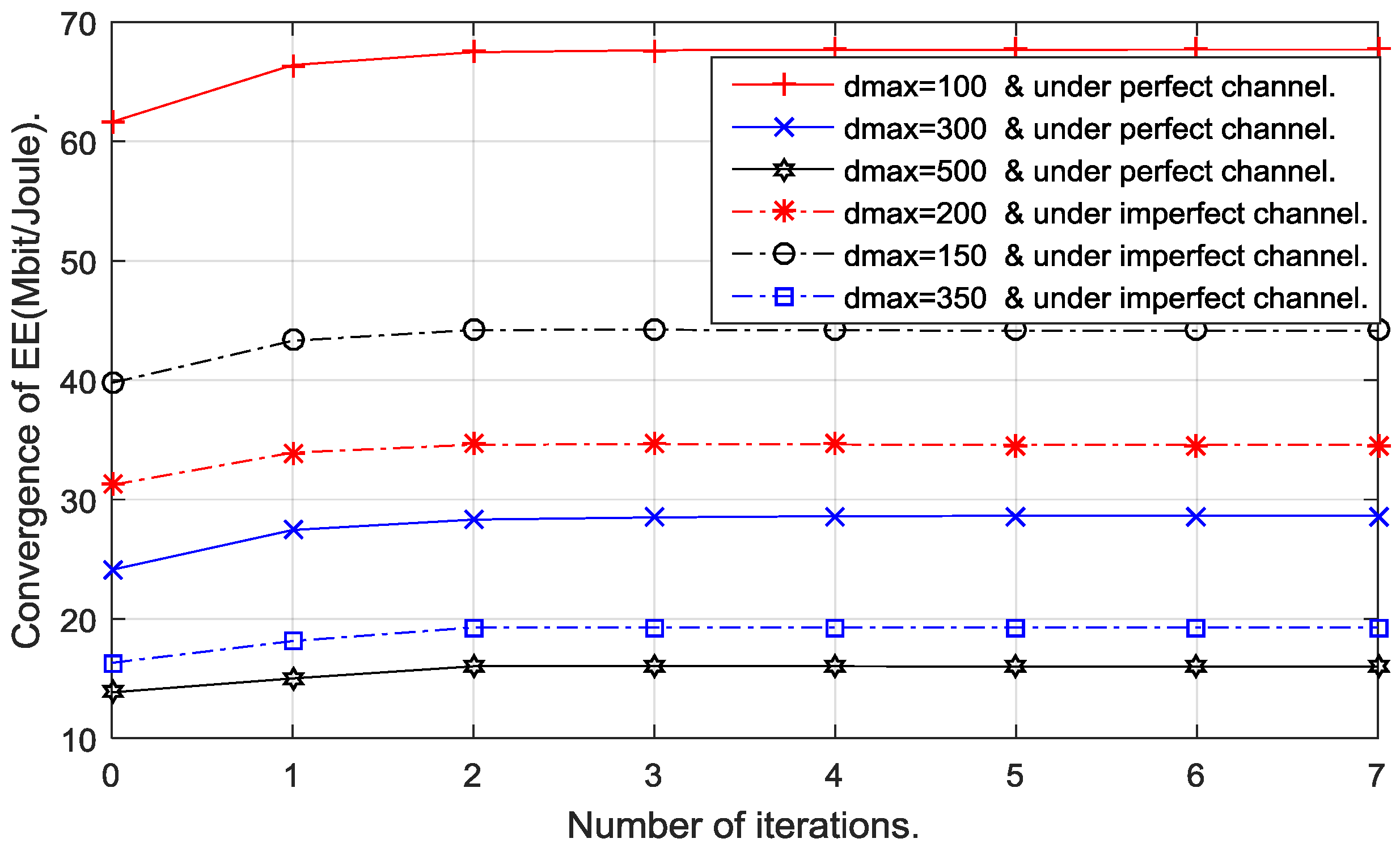
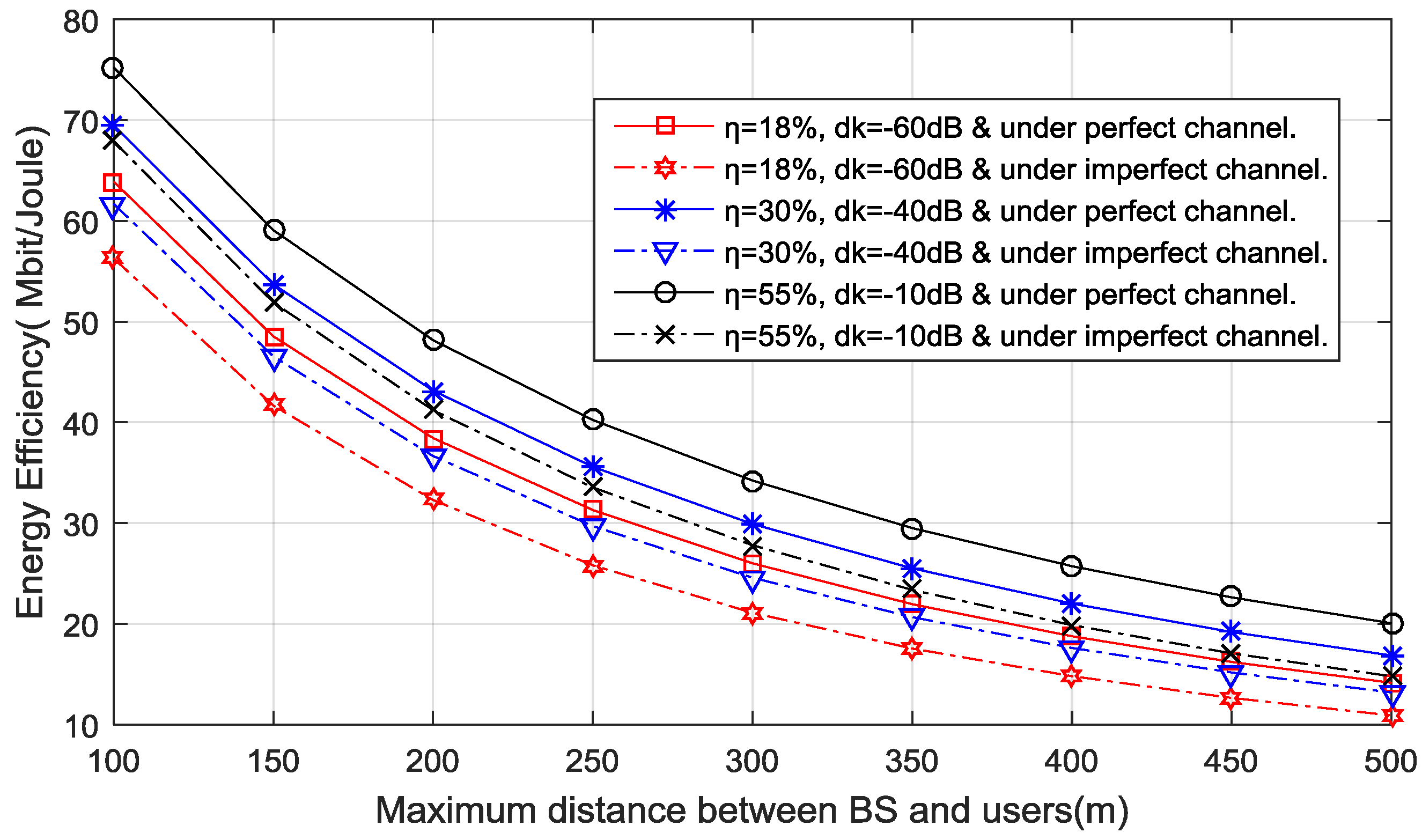
| Parameter | Value |
|---|---|
| Transmission Bandwidth () | 20 MHz |
| Coherence Block () | 1800 |
| Computational efficiency at BSs () | |
| Computational efficiency at Users () | |
| Clipping power Loses () | |
| Path loss exponent () | 3.8 |
| Distortion () | −25 dB |
| Total Noise Power () | −96 dBm |
| Pilot Lengths (,) | 1 m, 2m |
| Power Amplifier Efficiency when fixed () | 0.34 |
© 2018 by the authors. Licensee MDPI, Basel, Switzerland. This article is an open access article distributed under the terms and conditions of the Creative Commons Attribution (CC BY) license (http://creativecommons.org/licenses/by/4.0/).
Share and Cite
Ahmad Khan, A.; Uthansakul, P.; Duangmanee, P.; Uthansakul, M. Energy Efficient Design of Massive MIMO by Considering the Effects of Nonlinear Amplifiers. Energies 2018, 11, 1045. https://doi.org/10.3390/en11051045
Ahmad Khan A, Uthansakul P, Duangmanee P, Uthansakul M. Energy Efficient Design of Massive MIMO by Considering the Effects of Nonlinear Amplifiers. Energies. 2018; 11(5):1045. https://doi.org/10.3390/en11051045
Chicago/Turabian StyleAhmad Khan, Arfat, Peerapong Uthansakul, Pumin Duangmanee, and Monthippa Uthansakul. 2018. "Energy Efficient Design of Massive MIMO by Considering the Effects of Nonlinear Amplifiers" Energies 11, no. 5: 1045. https://doi.org/10.3390/en11051045
APA StyleAhmad Khan, A., Uthansakul, P., Duangmanee, P., & Uthansakul, M. (2018). Energy Efficient Design of Massive MIMO by Considering the Effects of Nonlinear Amplifiers. Energies, 11(5), 1045. https://doi.org/10.3390/en11051045





